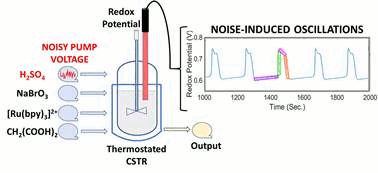当前位置:
X-MOL 学术
›
React. Chem. Eng.
›
论文详情
Our official English website, www.x-mol.net, welcomes your feedback! (Note: you will need to create a separate account there.)
Feed rate noise modulates autocatalysis and shapes the oscillations of the Belousov–Zhabotinsky reaction in a continuous stirred tank reactor†
Reaction Chemistry & Engineering ( IF 3.9 ) Pub Date : 2018-01-30 00:00:00 , DOI: 10.1039/c7re00196g Rohit Srivastava 1, 2, 3, 4 , Marta Dueñas-Díez 1, 2, 3, 4, 5 , Juan Pérez-Mercader 1, 2, 3, 4, 6
Reaction Chemistry & Engineering ( IF 3.9 ) Pub Date : 2018-01-30 00:00:00 , DOI: 10.1039/c7re00196g Rohit Srivastava 1, 2, 3, 4 , Marta Dueñas-Díez 1, 2, 3, 4, 5 , Juan Pérez-Mercader 1, 2, 3, 4, 6
Affiliation

|
Metabolism, just like other functions in living systems, involves chemical oscillators, and the detailed metabolic oscillation profiles reflect the preferential pathways in the complex metabolism reaction network, as well as the thermodynamics of metabolism. Living systems are open and subject to a noisy environment; hence it is natural to question how noisy reactant intake affects the chemical response, i.e. the detailed resulting oscillations, of an open complex chemical oscillatory system. In this paper, we use a chemical analogue of noisy “metabolism”, by applying white Gaussian noise on the feed rates of the [Ru(bpy)2]3+ catalyzed Belousov–Zhabotinsky (B–Z) reaction running in a continuous stirred tank reactor (CSTR). The noise was applied to the flow rate of a reactant one at a time, in the excitability region (near the Hopf bifurcation), and we observed its effect on the dynamical response, e.g. the features of the noise-induced oscillatory profiles. We show experimentally that noise on a specific reactant tunes the shape of the relaxation oscillations, and we link the observed effects to the most affected subnetworks in the Field–Körös–Noyes (FKN) mechanism. Hence, the autocatalytic loop is most affected by the noise on the acid feed rate and on the bromate feed rate pumping systems. This tuning of the oscillation shape together with the more studied ability to tune the amplitude and period of the noise oscillations by the noise parameters allows achieving distinct oscillations (shape + period + amplitude) not attainable in deterministic operation. Furthermore, noise on a specific reactant feed can thus be used to direct the reaction to a given pathway. Our results can be used to develop methods to force chemical and/or biological systems into desired dynamical regimes not otherwise easily attainable.
中文翻译:

进料速率噪声可调节自动催化作用,并影响连续搅拌釜反应器中Belousov–Zhabotinsky反应的振荡†
就像生命系统中的其他功能一样,新陈代谢也涉及化学振荡器,详细的新陈代谢振荡轮廓反映了复杂新陈代谢反应网络中的优先途径以及新陈代谢的热力学。生命系统是开放的,并且处于嘈杂的环境中;因此,很自然地会质疑嘈杂的反应物摄入如何影响开放式复杂化学振荡系统的化学响应,即详细产生的振荡。在本文中,我们通过对[Ru(bpy)2 ] 3+的进料速率施加高斯白噪声,使用具有噪声的“新陈代谢”的化学类似物在连续搅拌釜反应器(CSTR)中运行的催化Belousov–Zhabotinsky(B–Z)反应。在兴奋性区域(霍普夫分叉附近),将噪声一次施加到一种反应物的流速上,我们观察到了它对动力学响应的影响,例如噪声引起的振荡轮廓的特征。我们通过实验表明,特定反应物上的噪声会调整弛豫振荡的形状,并将观察到的效应链接到Field-Körös-Noyes(FKN)机制中受影响最大的子网。因此,自催化回路受酸进料速率和溴酸盐进料速率泵送系统上的噪声影响最大。振荡形状的这种调整以及通过噪声参数对噪声振荡的幅度和周期进行更深入研究的能力,可以实现确定性操作无法获得的独特振荡(形状+周期+幅度)。此外,特定反应物进料上的噪音因此可以用来将反应引导至给定的路径。
更新日期:2018-01-30
中文翻译:

进料速率噪声可调节自动催化作用,并影响连续搅拌釜反应器中Belousov–Zhabotinsky反应的振荡†
就像生命系统中的其他功能一样,新陈代谢也涉及化学振荡器,详细的新陈代谢振荡轮廓反映了复杂新陈代谢反应网络中的优先途径以及新陈代谢的热力学。生命系统是开放的,并且处于嘈杂的环境中;因此,很自然地会质疑嘈杂的反应物摄入如何影响开放式复杂化学振荡系统的化学响应,即详细产生的振荡。在本文中,我们通过对[Ru(bpy)2 ] 3+的进料速率施加高斯白噪声,使用具有噪声的“新陈代谢”的化学类似物在连续搅拌釜反应器(CSTR)中运行的催化Belousov–Zhabotinsky(B–Z)反应。在兴奋性区域(霍普夫分叉附近),将噪声一次施加到一种反应物的流速上,我们观察到了它对动力学响应的影响,例如噪声引起的振荡轮廓的特征。我们通过实验表明,特定反应物上的噪声会调整弛豫振荡的形状,并将观察到的效应链接到Field-Körös-Noyes(FKN)机制中受影响最大的子网。因此,自催化回路受酸进料速率和溴酸盐进料速率泵送系统上的噪声影响最大。振荡形状的这种调整以及通过噪声参数对噪声振荡的幅度和周期进行更深入研究的能力,可以实现确定性操作无法获得的独特振荡(形状+周期+幅度)。此外,特定反应物进料上的噪音因此可以用来将反应引导至给定的路径。



























 京公网安备 11010802027423号
京公网安备 11010802027423号